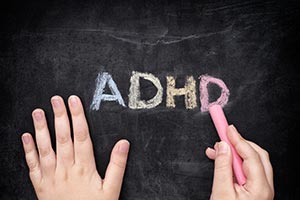
Attention-deficit/hyperactivity disorder (ADHD) is a behavioral disorder believed to affect up to 1 in 20 children in the United States. The diagnosis of ADHD has skyrocketed over the past decade. From 2000 to 2010, U.S. children and teens diagnosed with attention-deficit hyperactivity disorder jumped from 6.2 million to 10.4 million. It is characterized by symptoms of inattention and/or impulsivity and hyperactivity which can significantly impact on many aspects of behavior and performance, both at school and at home.
Effects on Daily Life
It is important to note that the criteria for ADHD state that symptoms must cause significant impairment in two or more settings (i.e. school and home). Thus, a child who has difficulties at home but none in school, or vice versa would not fit the diagnostic criteria. There are currently no laboratory or imaging studies that are reliable for the diagnosis of ADHD. In approximately 80% of children with ADHD, symptoms persist into adolescence and may even continue into adulthood. The effects of ADHD significantly impact the individual throughout childhood and well into adult life, especially if not managed optimally.
People with ADHD tend to have a lower occupational status, poor social relationships and are more likely to commit driving offenses and develop substance abuse. Parents and siblings also suffer as a result of the behavioral problems associated with ADHD. Increased levels of stress are common as are depression and marital discord. ADHD is now the most common neurobehavioral disorder in children. As of 2012, 11 percent of U.S. children had been diagnosed with ADHD, according to the Centers for Disease Control and Prevention (CDC).
Conventional Treatment Options
The conventional medical approach to the treatment of ADHD is a combination of medication and behavior therapy. Stimulants such as methylphenidate (e.g., Ritalin), amphetamines (e.g., Adderall) or other types of medications such as Strattera or Intuniv are often used to treat the symptoms of ADHD. As of 2008, an estimated 2.8 million of children under the age of 19 years were taking a stimulant medication such as Ritalin for ADHD. This is up from 150,000 in 1970 and less than a million as recently as 1990. Multiple studies show these medications to be effective in reducing ADHD symptoms in the short term, but there are few longer-term studies.
Adverse effects of stimulants occur in up to 30% of children with ADHD, commonly including gastrointestinal symptoms, decreased appetite, headaches, tics, and sleep problems. Behavioral interventions include a wide variety of school- and home-based methods which are aimed at improving symptoms and school performance. These include behavioral modification, individual and family therapy, and cognitive therapy. Most studies show these behavioral therapies alone to be less effective, in the short term, than medication.
Integrative Treatment: Blending Conventional and “Alternative”
Integrative Medicine is a blend of conventional and “alternative” modalities. It is evidence based and makes use of all appropriate therapeutic approaches, healthcare professionals, and disciplines (both conventional and alternative), to achieve optimal health and healing. By weaving the best of these modalities with the best of conventional medicine, an Integrative Medicine practitioner creates a unique partnership between the patient, family, and primary & specialty care providers, to achieve optimal health and healing. Care plans often include recommendations and guidance in the following areas:
- Conventional Medicine
- Nutrition
- Exercise
- Botanical/herbal Medicine
- Vitamins/Supplements
- Manual Medicine (Osteopathy, Massage, PT, Chiropractic, Reflexology)
- Whole Body Systems (Traditional Chinese Medicine -TCM/Acupuncture, Ayurveda, Naturopathy, Homeopathy)
- Spirituality
- Mind-Body Medicine (Hypnosis, Biofeedback, Guided Imagery)
Emphasizing Nutrition
An Integrative Medicine approach to ADHD places a strong emphasis on nutrition. The American diet has changed drastically over the past 50 years. Nutritional guidance is paramount, as the standard American diet (SAD) is highly processed and notoriously deficient in so many nutrients. Research shows a strong link between the foods children eat and the symptoms of ADHD. Understanding the relationship nutrition plays in ADHD can help parents make important dietary modifications that correct deficiencies and improve symptoms. Almost 75% of children older than 2 years are deficient in Zinc; 60% are low in Magnesium, and just under 40% are deficient in Iron. Deficiencies in these minerals have been linked to ADHD. Omega-3 fats have also been found to be lacking in children with ADHD. Appropriate blood tests can identify deficiencies.
An understanding of the concept of glycemic index is also important. Glycemic index (GI) is the measurement of the body’s increase in blood sugar level from carbohydrate consumption. Although no studies have examined this issue specifically, it makes sense that children who eat foods high on the glycemic index may have volatile blood sugar levels which are reflected in their behavior. As Dr. David Ludwig of Boston’s Children Hospital explains,
“A child eats a breakfast that has no fat, no protein, and a high glycemic index—let’s say a bagel with fat-free cream cheese. His blood sugar goes up, but pretty soon it crashes, which triggers the release of stress hormones like adrenaline. What you’re left with, at around 10 a.m., is a kid with low blood sugar and lots of adrenaline circulating in his bloodstream. He’s jittery and fidgety and not paying attention. That’s going to look an awful lot like ADHD to his teacher.”
Sensitivities to certain foods or additives like dyes, preservatives, and flavorings can affect behavior in certain individuals, so guidance thru an elimination diet can also an important step. Correction of these nutritional imbalances or sensitivities takes time. Some improvements can be seen very quickly, others can take several months. If warranted, medication can be used as a bridge until the benefits of these corrections can be seen. The reward is tremendous though. As these body systems normalize, we are often able to wean the medications, sometimes completely.
When Stimulant Medications May Be Necessary
A diagnosis of ADHD does not mean the automatic use of stimulant medication. Usually, it is reasonable to try non-medical interventions before considering stimulants. There are 3 criteria that that may justify the use of stimulants when other interventions do not work.
- When the child’s attentional difficulties are so great that he or she is unable to learn and keep up academically.
- When ADHD causes severe social difficulties. Often ADHD children are so impulsive and pay so little attention to social signals that they end up friendless.
- When behavior at home has a seriously disruptive effect on family life, causing significant problems for the child, parents, and/or siblings.
Additional Recommendations
In addition to the nutritional guidelines, an Integrative Medicine practitioner may recommend the following:
- Exercising on a regular basis has a natural calming effect; it also raises levels of norepinephrine and dopamine, which facilitates the ability to focus attention. Non-competitive martial arts including tai chi and karate can improve self-discipline, boost concentration and slow the restless cascade of intrusive thoughts.
- Employing consistent and positive behavior management at home is very important as well. Children with ADHD are often subject to almost constant ongoing criticism. Focus on what they do well, not just the areas of difficulty.
- Make sure your child is getting the appropriate accommodations at school. Sometimes relatively simple school interventions can make a big difference
- Where appropriate, other modalities such as herbs, biofeedback, homeopathy, etc. can be very effective. Herbal therapies can be very beneficial in treating some of the co-existing issues such as anxiety, insomnia, abdominal pain, etc.
- Parent education and support are other important parts of treatment for a child with ADHD. Children with ADHD might not respond as well as other children to the usual parenting practices, so experts recommend additional parent education. This approach has been successful in teaching parents how to help their children become better organized, develop problem-solving skills, and cope with their ADHD symptoms. Parent education can be conducted in groups or with individual families and is offered by therapists or in special classes. Children and Adults with Attention Deficit/Hyperactivity Disorder (CHADD) offers a unique educational program to help parents and individuals with ADHD navigate the challenges of ADHD across the lifespan. Find more information about CHADD’s “Parent to Parent” program by visiting the CHADD website at www.chadd.org.
It is tempting to hope for a simple answer to explain a childhood neurological disease such as ADHD. However, most convincing studies point towards a combination of risk factors and exposures together. It is very unlikely to find a “magic bullet”. Rather, by identifying risk factors and making lifestyle modifications, improved outcomes will likely follow.
For a comprehensive guide, see the book ADHD Without Drugs by integrative physician Sanford Newmark, M.D. He is a graduate of the fellowship in Integrative Medicine at the University of Arizona. This book is strongly recommended to all parents and relatives of children with ADHD.
Further Reading
If you’re a parent of a child with ADHD, you’ll want to read this comprehensive post from Dr. Kay Trotter from Kaleidoscope Behavioral Health University: Parenting a Child with ADHD.


